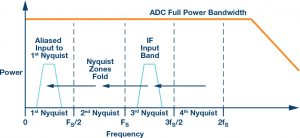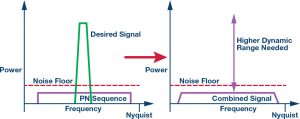Aerospace and defense applications such as electronic warfare and active phased array radar often require the use of a higher order Nyquist rate band to ferret out wider frequency communications. Not only is a larger observed bandwidth needed from a system ADC, but systems are also pushing the need for a higher full power bandwidth. If an ADC’s input frequency bandwidth is high enough, it is possible to downconvert directly within the ADC by undersampling the IF signal band of interest.


Figure 1. Wide ADC full power bandwidth allows the use of higher order Nyquist
bands. Band-pass filtering of the unused Nyquist zones is mandatory to remove
unwanted signal energy that could potentially fold back into the 1st Nyquist and impact the dynamic range
Higher bandwidth input signals and sample rates allow direct RF sampling of wider band signals. This permits the possible reduction of an entire stage in a signal chain for lower system power and simplicity. Next-generation GSPS ADCs allow GHz sampling well into the 3rd and 4th Nyquist band, with the capability to also get the dynamic range needed for small signal detection. A wideband ADC that also offers a higher dynamic range allows a system to move the noise floor lower to decipher weaker power signals that would have otherwise been buried in the noise.
For a system to reconstruct the original signal perfectly from the sampled data, the Nyquist-Shannon sampling theorem indicates that the sample rate must be twice the signal bandwidth of interest; distinctly different than a sample rate that is twice the maximum IF frequency component. ADC undersampling is the technique of using a sampling frequency, which is less than twice the maximum frequency component in the signal band. The signal bandwidth of interest must still be within a single Nyquist rate or half of the ADC sample rate. This technique can also be referred to as harmonic sampling, band-pass sampling, or super Nyquist sampling.


Figure 2. Direct sequence spread spectrum systems require a wide receiver
bandwidth and high dynamic range as the signal band of interest is modulated
with pseuorandom noise (PN) to push the communication into the noise floor
In order to maintain the Nyquist-Shannon sampling theorem, using a BW as the signal bandwidth of interest, then a sample frequency of Fs > 2 BW is required. The signal bandwidth of interest can be between dc to BW or from x to y, where BW is y – x. So long as the bandwidth of interest does not overlap an ADC’s Nyquist band, which is half of the sample rate (Fs), undersampling can work for higher signal bands with ADCs that have a high full power bandwidth (FPBW) relative to their respective sample rate as seen in Figure 1.
Secrecy is an important aspect of military operations. To reduce the probability of intercept or detection, the form and magnitude of a radar transmission is designed (in many cases) to spread energy over the widest possible frequency range. Low probability of intercept (LPI) and low probability of detection (LPD) are classes of radar systems that possess certain performance characteristics that make them nearly undetectable by today’s modern intercept receivers. LPI features prevent the radar from tripping off alarm systems or passive radar detection equipment.
To provide resistance to jamming, systems can be architected by intelligently randomizing and spreading the radar pulses over a wide band so there will only be a very small signal on any one band, which is known as direct sequence spread spectrum (DSSS), as seen in Figure 2. Frequency hop spread spectrum (FHSS) also provides some protection against full-band jamming. In these cases, the wide transmission signal consumes bandwidth that is in excess of what is actually needed for the raw signal of interest. Therefore, a wider receiver bandwidth and higher dynamic range are needed to continue to advance system capability.
One of the most important factors for success in an LPI system is to use as wide of a signal transmission bandwidth as possible to disguise complex waveforms as noise. This conversely provides a higher order challenge for intercept receiver systems that seek to detect and decipher these wideband signals. Therefore, while this creates improvements toward LPI and LPD, it also increases radar transceiver complexity by mandating a system that can capture the entire transmission bandwidth at once. The ability of an ADC to simultaneously digitize 500 MHz and 1000 MHz, as well as larger chunks of spectrum bandwidth in a single Nyquist band, with high dynamic range helps provide a means to tackle this system challenge. Moving these bands higher in frequency beyond the first Nyquist of the ADC can be even more valuable. Today’s wideband ADCs offer systems potential for multiple wide Nyquist bands within an undersampling mode of operation. However, using a high order ADC Nyquist band to sample requires strict front-end antialias filtering and frequency planning to prevent spectral energy from leaking into other Nyquist zones. It also ensures that unwanted harmonics and other lower frequency signals do not fall into the band of interest after it is folded down to the 1st Nyquist. The band-pass filter (BPF) upstream of the ADC must be designed to filter out unwanted signals and noise that are not near the nominal bandwidth of interest. New GSPS ADCs such as AD9234, AD9680, and AD9625 offer multiple Nyquist band sampling with high dynamic range across wide input bandwidths.


Figure 3. The undersampling technique can potentially remove a downconversion stage as the higher input frequency band is given directly to the RF sampling ADC
Since a direct sampling technique folds the signal energy from each zone back into the 1st Nyquist, there is no way to accurately discriminate the source of the content frequency. As a result, rogue energy can appear in the 1st Nyquist zone, which will degrade the signal-to-noise ratio (SNR) and spurious-free dynamic range (SFDR). Spectral issues have the potential to plague government and military applications, both for communications and sensing. Digital radio transceivers for military communications are another example of the use of high speed ADCs and DACs that can potentially replace a traditional baseband mixer stage. The architecture has several advantages because tight filtering and adjacent channel rejection can be done in the digital domain for the baseband conversion.
Several advantages are offered by direct RF sampling for radar RF front-end designs. First and foremost, it can allow component count reduction, as can be seen in Figure 3, when an entire downconversion stage can be eliminated. It also removes the need to design a mixing chip to fit a uniquely tailored frequency plan. Second, it can simplify the design of next-generation receivers for future signal bandwidths that become available as radar systems are modernized and updated. All that may be needed to work with a new carrier frequency is to select an appropriate sampling rate and incorporate an appropriate band-pass filter. Third, it is possible to make a single RF front end suitable for multiple frequency bands, given different sample rates. This approach to multifrequency radar receiver front-end design eliminates the need for multiple front ends.
Current generation ADCs now offer a plurality of internal digital downconversion (DDC) processing blocks for narrow-band inspection of a communication. Each DDC can apply its own decimation rate and numerically controlled oscillator for tuning placement within a Nyquist band. Processing gain can be achieved within a narrower bandwidth that digitally filters out-of-band noise. This reduces the required ADC output data and minimizes processing complexity in FPGAs and DSPs. However, additional channelizer signal processing can also be done downstream of the ADC.
Wideband communications and sensing systems require extremely high speed data converters. State-of-the-art GSPS ADCs such as AD9234, AD9680, and AD9625 not only offer high sample rates for a wider instantaneous bandwidth, but also the ability to sample high frequency inputs with high dynamic range above the 1st Nyquist. A single direct RF sampling ADC used at a high bandwidth can potentially replace an entire IF sampling or zero IF sampling subsystem of mixers, LO synthesizers, amplifiers, and filters while achieving greater flexibility. This can significantly reduce the system bill of materials (BOM) cost, design time, board size, weight, and power consumption.
References
Kester, Walt. MT-002 Tutorial, What the Nyquist Criterion Means to Your Sampled Data System Design. Analog Devices, Inc.
Poshala, Purnachandar. “Why Oversample when Undersampling can do the Job?” EE Times India, June 2013. Shea,
John. Military Wireless Communications. University of Florida. Stallings,
William. Data and Computer Communications. Pearson Prentice Hall, 2013.
Zarr, Richard. “ADCs Feel the Need for Speed.” Electronic Design, 2014.
About the Author
Ian Beavers is an applications engineer for the high speed ADCs team at Analog Devices in Greensboro, NC. He has worked for the company since 1999. Ian has over 20 years of experience in the semiconductor industry. Ian earned a bachelor’s degree in electrical engineering from North Carolina State University and an MBA from the University of North Carolina in Greensboro. Ian is a member of EngineerZone’s High Speed ADC Support Community. Feel free to send your questions to IanB on Analog Devices EngineerZone Online Technical Support Community.











